Le Couvent - The Sisters of the Presentation of Mary
The arrival of the Sisters of the Presentation of Mary are closely implicated with the new local church. The Rev. Jean-Baptiste Chartier, the local priest, was well aware of all the sisters associated with the various dioceses since 1853. He wanted to have some of these religious women here in order to instruct and educate the young women. The Rev. Chartier proceded to have built a stone and granite convent (45 ft. X 35 ft.) near the existing chapel. Sister St.-Louis de Gonzague and two other nuns arrrived at the presbytery on September 15, 1870. Classes started on October 3, with 40 children of which 13 were boarders. The majority of the students were French- speaking and Catholic, other students were English-speaking and of various Protestant denominations.
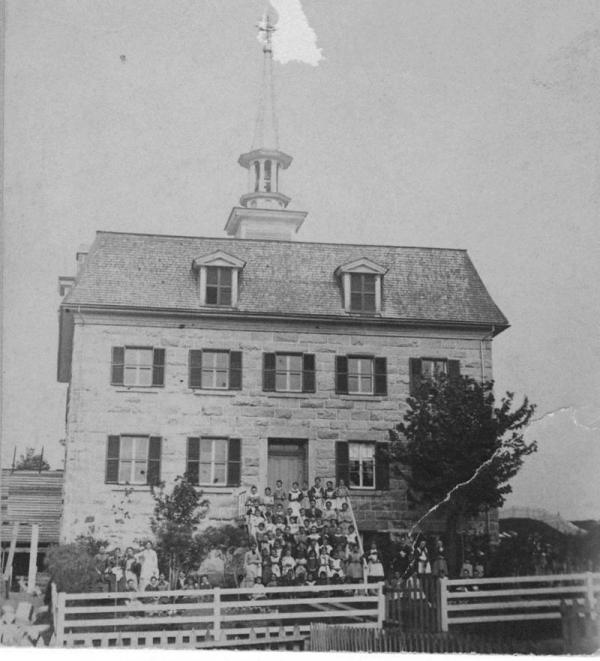
The first partr of the Couvent, built in 1870
In the year 1875, and in the early days of the convent, it was definitely not an easy or optimistic time for the Rev. Chartier and for many people in Coaticook. Financial resources were scarce for both the local families and the nuns. With the idea in mind of saving the work already completed and to continue teaching, the nuns decided to organize a bazaar with the help of the local ladies and other interested citizens to enable the project to continue in a more financially sound manner. Thanks to the assistance of the clergy and certain citizens in the spring of 1883, the community of the Presentation of Mary acquired the Convent as well as the adjacent property. In the same year, plans were made for the first expansion.
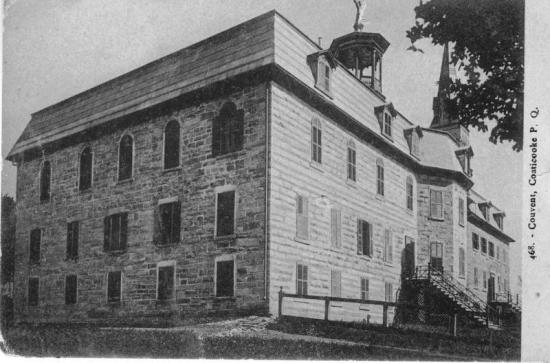
Convent with its second part
In February 1884, with the consent of the Honorable Mr. Racine, Bishop of Sherbrooke, leaders and business men of the community entered into an agreement allowing for the expansion of the project, to proceed. Everything for the return of the students in September. A second expansion was built in 1897, this expansion would be done behind the first building while the expansion of 1884, was built along St. Jacques Street. This addition will be essential to accommodate the sisters and the 90 expected boarders, many of whom would be coming from the New England states. In 1902 and in 1907, two other additions were built: the new Chapel, music rooms and, dormitories. This addition will show the Convent for the first time in the majestic style that is familiar to us today.
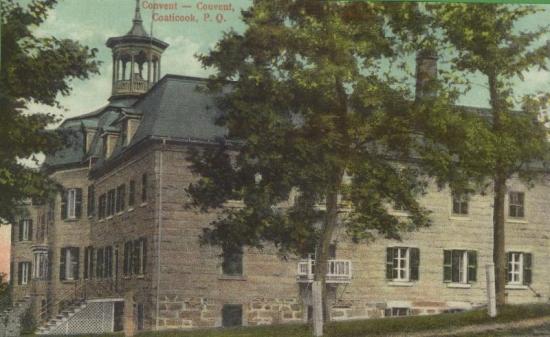
Expansion of the Convent
In 1971, the addition of a gymnasium and four more classrooms were built to meet the requirements of the Ministry of Education. A walkway connected the buildings. In 1986, a new expansion was built in order to update the kitchen and cafeteria and accomodations for the sisters.
In 1977, a secular corporation bought a house on Wellington Street in order to provide lodging for boarders who were increasingly being admitted for enrollment. This house would be demolished and replaced by a building on Main Street East where 26 students will be housed. In 1983, the community purchased the old St. Michel School to be converted into dormitories. Fifty-six boarders found a place here and in 1997 this residence was sold to the MRC of Coaticook.
In 1870, with the opening of the Convent, preparatory and elementary classes were held. These courses were given in French and English according to the need in the community. To complete their studies, students would receive, beginning in 1909, a high school leaving certificate or a higher certificate for teaching from the Quebec Examination Board. The High School (Rivier College in 1923) would be affiliated with Washington University as well as the University of Montreal. In 1929, the first Letters in Science university level courses was given and was affiliated with the University of Montreal and, later, with the University of Sherbrooke. Commercial courses were added to the courses from 1946 to 1956.
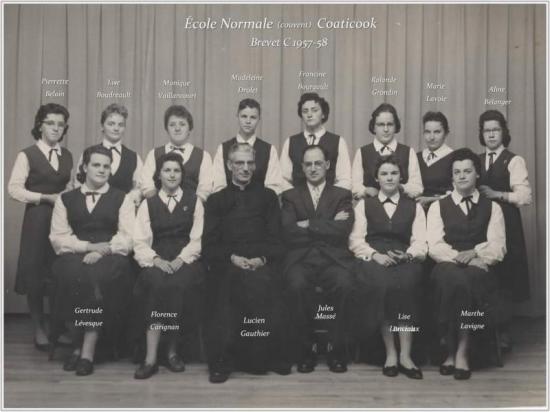
Students obtening a certificate 1957-58
In 1957, The Nouvelle-France School was established. The graduates of this program would receive a Teacher's Certificate from the Ministry of Education. In 1965, the Convent expanded the Science courses to be completed in four years: Letters in Science and Letters in Mathematical Science. In 1967, another grade of learning was added to the high school, or Grade XII. Our distinguished Convent always in the forefront of educating young people, both in the past and today, is always in adjustment of the mandate for the school.
Arts and Culture at the Convent
Throughout all the educational programs, there has always been a place for music, singing, public speaking, theater, drawing, painting, domestic and plastic arts, crafts, physical education and sports. As early as 1884, there were 40 students studying the piano. In 1916, the Chapel was installed with a Casavant organ which allowed for the practice of church music as well as enhancing regular services. The walls of the Convent have been witness to many artistic, cultured and sports events.
Changes in the School Name
At the time of the foundation of the school in 1870, the sisters welcomed student boarders to the establishment which was known as the Convent at that time. The expansion of the Convent in 1907, complete with an extension of 215 feet, led to the people of Coaticook calling the structure Le Grand Convent. Subsequently, according to the times and changing circumstances, name changes became the norm: Pensionnat de Coaticook (Boarding School) in 1936, Pensionnat Reine de l'Estrie in 1948, Pensionnat Notre-Dame de l'Estrie in 1953, Ecole Normale Nouvelle-France in 1957, Pensionnat Notre Dame de la Presentation in 1966 and, in 1990, le College Rivier. Despite going through some difficult times trying to comply with requests from the government and the Ministry of Education, the Convent was able to maintain its private school status. The Convent continued its mandate by focusing on the specific need of the population and adjusting to the times. In 1903, the community opened a Convent for young girls in Stanhope. This high school drew in a number of students from the New England states as well as girls from the region and elsewhere. In 1973, the Convent in Stanhope known as the Notre Dame des Neiges Convent closed. The students continued their education in Compton until 1983, at the Freres des Ecoles chretiennes.
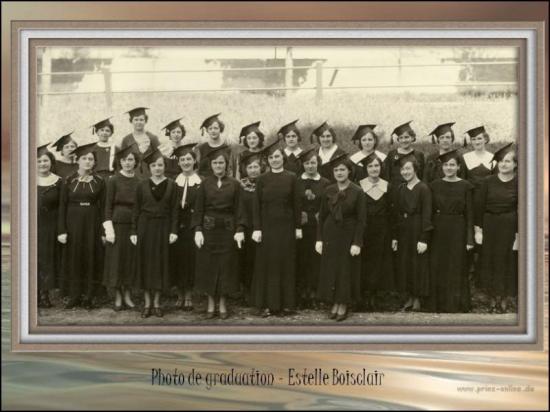
Graduation of graduates including Estelle Boisclair
The school boards in this area made their needs known to the nuns that principals and teachers were needed. We find them in Compton (1909-1966), in St. Hermenegilde (1915-1970), at the St. Jean de Coaticook School (1922-1950), at St. Marc School (1922-1971), at the St. Edmond and St. Michel School (1931-1963), the Gendreau School (1950-1973), the school in Barnston (1961-1972), the Monseigneur Durand School (1963-1967) and the Albert L'Heureux School (1967-1973).
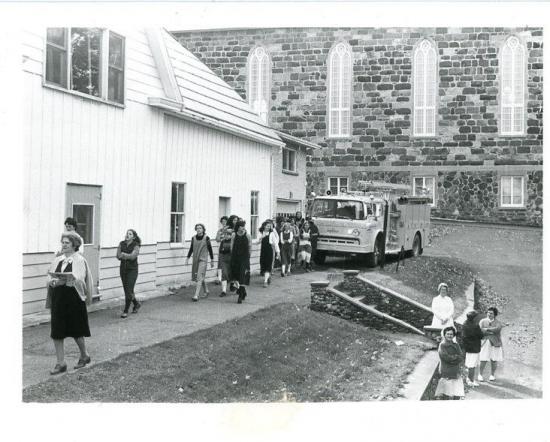
A fire practice carried out at the Convent
The Rev. Jean-Baptiste Chartier was able to get, through periodic correspondence, humble and generous nuns from the very beginning . These pioneers had come upon difficulties on occasion and were well equipped to face the particular challenges that were presented. The Archives tell us that in 1885, there were 15 sisters and 295 students, of which 112 were boarders at the Convent, and, 183 day students. The growth of the nuns teaching at the Convent was consistent until 1955 and were calculated according to the number of boarders at the facility. On the other hand, the opening of new schools from 1922 onward, led to the decrease of day students. Today, we see boarders and day students and they are all from the private sector.
Starting in 1995, boys were accepted as students and this helped to maintain relevance to the school, now 125 years of age. The principals and teachers who are teaching today are lay persons.
At a time of rapid change on many levels, College Rivier is perfectly capable of adjusting to change and to adapt to these changes while at the same time fulfilling its mandate of training and educating young people and preparing them for the future. The Convent and College Rivier is celebrating their 150th Anniversary.
This text was drawn from the book ''Coaticook'' as told by its citizens.
Reference: Sister Louise Guilbert



